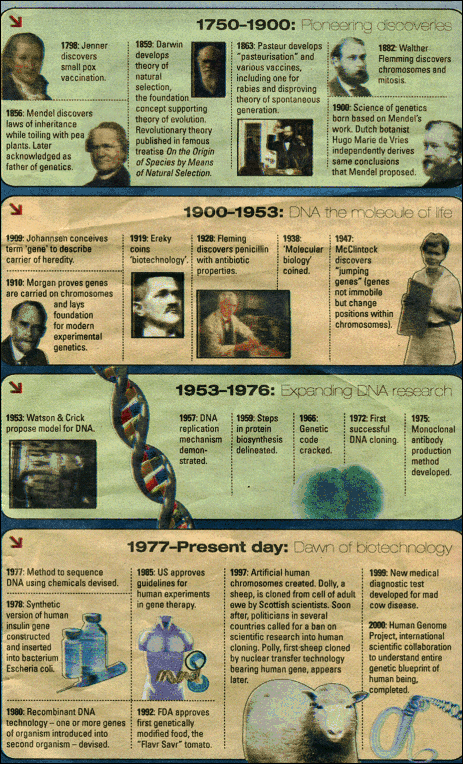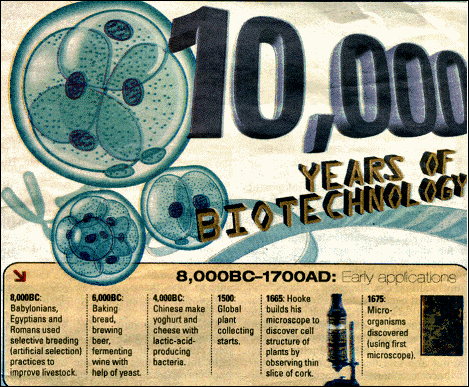Making biotech a driving force
Dato' Dzulkifli Abd Razak
Article
New Sunday Times - 05/08/2005
With the announcement of the National Biotechnology Policy by the Prime Minister at the opening of BioMalaysia 2005 recently, another "buzzword" has been introduced to the Malaysian community.
A few years ago, it was IT and ICT with the MSC (the Multimedia Super Corridor). Now it's BioValley and BioNexus. What do we make of these?
Let us backtrack to just over three decades, when a biochemist from the University of California in San Francisco and a geneticist from Stanford perfected a technique for inserting a toad's DNA into a bacterium.
The so-called newly-created life-form not only lived but also reproduced. It soon inspired the founding of a start-up called Genentech.
The company, which is operated out of the university, eventually raked in US$300 million by licensing the gene-splicing technology, creating new wealth not only for the scientists but also the university.
Thus, 1973 was regarded as the year the "biotech" (short for biotechnology) revolution began.
Five years later, Genentech once again captured the imagination of the world when it synthesised human insulin in bacterial cells.
About five percent of diabetics are allergic to animal insulins availabIe before. The rest is history.
"Biotechnology" is derived from the Greek words, bio (life) and technologia (systematic treatment).
It is largely understood as "a set of powerful tools that employ living organisms (or part of organisms) to make or modify products, improve plants or animals, or develop microorganisms for specific uses".
Or, "a collection of technologies that use living cells and/or biological molecules to solve problems and make useful products" (http://www.ncbiotech.org/biotech101/glossary.cfm).
Accordingly, examples of modern biotechnology include the use of recombinant DNA, cell fusion, novel bioprocessing techniques and bioremediation.

As different scientific disciplines emerge, the span of "biotech" also expanded to include areas of recombinant DNA, RNA and monoclonal antibody technologies; later neuroscience, genomic, proteomic, even generic data management and mining (the so-called "bioinformatics").
As a result, the definition of "biotech" is broaden even further to include diagnostic, reagent/assay and pharmaceutical and therapeutic products.
Historically, the use of living organisms to solve problems or make useful products is not entirely new.
As far back as ancient Egypt, there were indications of the involvement of "biotechnology" in the community.
Through the various scientific innovations, the baking of bread using fermentation techniques, for example, was advanced based on an understanding of the microbiological processes to make the dough rise.
This explains why there were more than 50 varieties of bread in Egypt since over 4000 years ago.
Early use of biotech ranged from traditional breeding techniques for animal and plant to the use of yeast in making beer, wine, cheese and bread.
Even before that, around 6,000 BC, there were records that the Babylonians and Sumerians were already using microbial yeast.
So, too, in China where among the first benefits of biotechnology is the use of moulds as a topical treatment for skin infections.
Recall how, very much later, Fleming discovered from the extract of a mould, the antibiotic penicillin which later became a new wonder drug, and revolutionised medicine.
In much the same way, many of our indigenous practices are based on biotechnological principles by using living organisms to solve problems and make new products.
Many of them were inspired by nature, the way it inspired today's biotechnology. The basic difference, perhaps, is the level of sophistication, thanks to advances of in high-technologies.
But that is not to say biotech is not totally alien to our society if the contribution of indigenous knowledge is taken into account.
This aspect cannot be over-emphasised in our push to make biotech the country's engine of growth if we are keen to engage the participation of the larger population.
Instead the national approach to biotech must be made more inclusive so that no one will be alienated, and there will be lesser of a divide as compared to the case of ICT.
In short, biotech can be an everyday occurrence.
Although the more modern biotech is where the new challenges are, it is imperative that Malaysia makes an inventory all of its indigenous biotech knowledge and practices.
This will provide an excellent platform to "transform" them into modern biotech knowledge and practices, especially in enriching the agro-health sector.
We need to remind ourselves that It was only in the last century that plant-derived products were replaced by synthetic petroleum derivatives.
While this was a remarkable transformation, the starting point often involved bioresources, without which the development of biotech would have been hampered.
By learning from nature and appropriately applying it to biotechnology, many novel compounds and processes are being discovered.
Overall, these are the "innovations" that will cause vast improvements in both agricultural and industrial applications as well as making production more efficient. They are also more environment-friendly, although it is not totally risk-free.
Cumulatively, biotech will be the new driving force not only for new wealth creation but also social well-being of Malaysians as the theme of BioMalaysia 2O05 indicates.
Still, unless biotech, both indigenous and modern, are properly integrated and understood, and appropriately harnessed, our journey to an exciting biobased future can be an arduous one.
Recommended site: http://www/biozone.co.uk/biolinks/BIOTECHNOLOGY.html
Article
New Sunday Times - 05/08/2005
With the announcement of the National Biotechnology Policy by the Prime Minister at the opening of BioMalaysia 2005 recently, another "buzzword" has been introduced to the Malaysian community.
A few years ago, it was IT and ICT with the MSC (the Multimedia Super Corridor). Now it's BioValley and BioNexus. What do we make of these?
Let us backtrack to just over three decades, when a biochemist from the University of California in San Francisco and a geneticist from Stanford perfected a technique for inserting a toad's DNA into a bacterium.
The so-called newly-created life-form not only lived but also reproduced. It soon inspired the founding of a start-up called Genentech.
The company, which is operated out of the university, eventually raked in US$300 million by licensing the gene-splicing technology, creating new wealth not only for the scientists but also the university.
Thus, 1973 was regarded as the year the "biotech" (short for biotechnology) revolution began.
Five years later, Genentech once again captured the imagination of the world when it synthesised human insulin in bacterial cells.
About five percent of diabetics are allergic to animal insulins availabIe before. The rest is history.
"Biotechnology" is derived from the Greek words, bio (life) and technologia (systematic treatment).
It is largely understood as "a set of powerful tools that employ living organisms (or part of organisms) to make or modify products, improve plants or animals, or develop microorganisms for specific uses".
Or, "a collection of technologies that use living cells and/or biological molecules to solve problems and make useful products" (http://www.ncbiotech.org/biotech101/glossary.cfm).
Accordingly, examples of modern biotechnology include the use of recombinant DNA, cell fusion, novel bioprocessing techniques and bioremediation.


As different scientific disciplines emerge, the span of "biotech" also expanded to include areas of recombinant DNA, RNA and monoclonal antibody technologies; later neuroscience, genomic, proteomic, even generic data management and mining (the so-called "bioinformatics").
As a result, the definition of "biotech" is broaden even further to include diagnostic, reagent/assay and pharmaceutical and therapeutic products.
Historically, the use of living organisms to solve problems or make useful products is not entirely new.
As far back as ancient Egypt, there were indications of the involvement of "biotechnology" in the community.
Through the various scientific innovations, the baking of bread using fermentation techniques, for example, was advanced based on an understanding of the microbiological processes to make the dough rise.
This explains why there were more than 50 varieties of bread in Egypt since over 4000 years ago.
Early use of biotech ranged from traditional breeding techniques for animal and plant to the use of yeast in making beer, wine, cheese and bread.
Even before that, around 6,000 BC, there were records that the Babylonians and Sumerians were already using microbial yeast.
So, too, in China where among the first benefits of biotechnology is the use of moulds as a topical treatment for skin infections.
Recall how, very much later, Fleming discovered from the extract of a mould, the antibiotic penicillin which later became a new wonder drug, and revolutionised medicine.
In much the same way, many of our indigenous practices are based on biotechnological principles by using living organisms to solve problems and make new products.
Many of them were inspired by nature, the way it inspired today's biotechnology. The basic difference, perhaps, is the level of sophistication, thanks to advances of in high-technologies.
But that is not to say biotech is not totally alien to our society if the contribution of indigenous knowledge is taken into account.
This aspect cannot be over-emphasised in our push to make biotech the country's engine of growth if we are keen to engage the participation of the larger population.
Instead the national approach to biotech must be made more inclusive so that no one will be alienated, and there will be lesser of a divide as compared to the case of ICT.
In short, biotech can be an everyday occurrence.
Although the more modern biotech is where the new challenges are, it is imperative that Malaysia makes an inventory all of its indigenous biotech knowledge and practices.
This will provide an excellent platform to "transform" them into modern biotech knowledge and practices, especially in enriching the agro-health sector.
We need to remind ourselves that It was only in the last century that plant-derived products were replaced by synthetic petroleum derivatives.
While this was a remarkable transformation, the starting point often involved bioresources, without which the development of biotech would have been hampered.
By learning from nature and appropriately applying it to biotechnology, many novel compounds and processes are being discovered.
Overall, these are the "innovations" that will cause vast improvements in both agricultural and industrial applications as well as making production more efficient. They are also more environment-friendly, although it is not totally risk-free.
Cumulatively, biotech will be the new driving force not only for new wealth creation but also social well-being of Malaysians as the theme of BioMalaysia 2O05 indicates.
Still, unless biotech, both indigenous and modern, are properly integrated and understood, and appropriately harnessed, our journey to an exciting biobased future can be an arduous one.
Recommended site: http://www/biozone.co.uk/biolinks/BIOTECHNOLOGY.html
